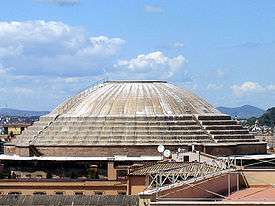Roman Architectural Revolution

The Roman Architectural Revolution, also known as the concrete Revolution,[2] was the widespread use in Roman architecture of the previously little-used architectural forms of the arch, vault, and dome. For the first time in history, their potential was fully exploited in the construction of a wide range of civil engineering structures, public buildings, and military facilities. These included amphitheatres, aqueducts, baths, bridges, circuses, dams, domes, harbours, and temples.
A crucial factor in this development that saw a trend to monumental architecture was the invention of Roman concrete (also called opus caementicium), which led to the liberation of the shape from the dictate of the traditional materials of stone and brick.[3]
For the first time in recorded history we find evidence of an interest in the shapes of the space contained strong enough to outweigh the functional logic of the masonry masses that contained it. There was nothing new in the employment of curvilinear or polygonal forms, as such...But in so far as such buildings incorporated curvilinear or polygonal rooms and corridors, the shapes of these were determined by the form of the building as a whole, not by any aesthetic principle.— [3]
The development of Roman architecture, however, did not remain limited to these new forms and materials. An unrelated process of architectural innovation continued unabated, which, although less conspicuous, proved their usefulness for solving structural problems and found their way permanently into Western architecture, such as the lintel arch, the independent corbel, and the metal-tie.[4]
See also
Footnotes
- ↑ The Roman Pantheon: The Triumph of Concrete
- ↑ DeLaine 1990, p. 407; Rook 1992, pp. 18f.; Gardner 2005, p. 170
- 1 2 Ward-Perkins 1956, p. 219
- ↑ DeLaine 1990, p. 407
References
- Ball, Larry (2003), The Domus Aurea and the Roman Architectural Revolution, Cambridge University Press, ISBN 978-0-521-82251-0
- DeLaine, Janet (1990), "Structural Experimentation: The Lintel Arch, Corbel and Tie in Western Roman Architecture", World Archaeology, 21 (3): 407–424 (407), doi:10.1080/00438243.1990.9980116
- Gardner, Helen (2005), Gardner's Art Through The Ages: The Western Perspective, Wadsworth Publishing, p. 170, ISBN 978-0-495-00479-0
- Lechtman, H. N.; Hobbs, L. W. (1987), "Roman Concrete and the Roman Architectural Revolution", Ceramics and Civilization, 3, pp. 81–128
- MacDonald, William (1982), The Architecture of the Roman Empire (2nd ed.), Yale University Press, pp. 38–46, 141–146, 167–183, ISBN 978-0-300-02819-5
- McKay, A. G. (1975), Houses, Villas and Palaces in the Roman World, The Johns Hopkins University Press, pp. 130–131
- Ward-Perkins, J. B. (1956), "Nero's Golden House", Antiquity, 30: 209–219 (217–19)
- Ward-Perkins, J. B. (1981), Roman Imperial Architecture (2nd ed.), The Yale University, pp. 97–120, ISBN 978-0-300-05292-3
- Rook, Tony (1992), Roman Baths in Britain, Osprey Publishing, pp. 18–19, ISBN 978-0-7478-0157-3
- Sear, Frank (1982), Roman Architecture, Cornell University Press, pp. 101–102, ISBN 978-0-8014-9245-7
Further reading
- Adam, Jean-Pierre (2005), Roman Building. Materials and Techniques, Routledge, ISBN 0-203-98436-6
- Lancaster, Lynne (2005), Concrete Vaulted Construction in Imperial Rome. Innovations in Context, Cambridge University Press, ISBN 978-0-511-16068-4
- MacDonald, William (1958), "Some Implications of Later Roman Construction", The Journal of the Society of Architectural Historians, Society of Architectural Historians, 17 (4): 2–8, doi:10.2307/987944, JSTOR 987944
External links
- Traianus – Technical investigation of Roman public works
- The Roman Pantheon: The Triumph of Concrete
- Fikret Yegul: Roman Concrete
- Roman aqueducts: Types of Opus Caementicium walls